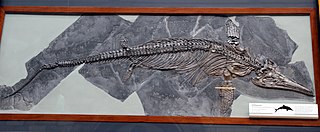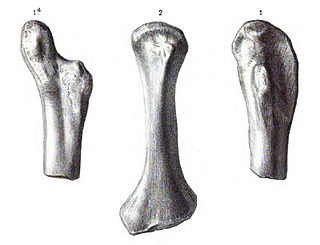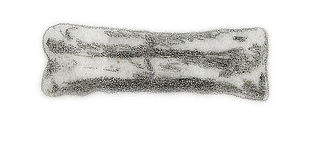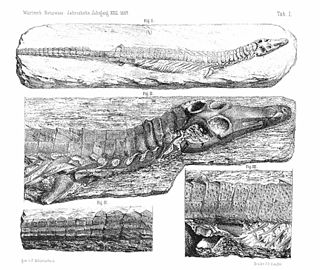
Ichthyosaurs are large extinct marine reptiles. Ichthyosaurs belong to the order known as Ichthyosauria or Ichthyopterygia.

Ichthyopterygia was a designation introduced by Sir Richard Owen in 1840 to designate the Jurassic ichthyosaurs that were known at the time, but the term is now used more often for both true Ichthyosauria and their more primitive early and middle Triassic ancestors.

Ichthyosaurus is a genus of ichthyosaurs from the Early Jurassic, with possible Late Triassic record, from Europe. It is among the best known ichthyosaur genera, as it is the type genus of the order Ichthyosauria.

Shonisaurus is a very large genus of ichthyosaur. At least 37 incomplete fossil specimens of the marine reptile have been found in the Luning Formation of Nevada, USA. This formation dates to the late Carnian age of the late Triassic period, about 237–227 million years ago.

Actiosaurus is an extinct genus of reptile first described by Henri Sauvage in 1883 from Antully bonebed, Autun. The type species is A. gaudryi. Little is known of it, and it is considered a nomen dubium. Actiosaurus was originally described as a dinosaur in 1883 and was reinterpreted as an ichthyosaur in 1908. Actiosaurus may instead represent the remains of a choristodere. Fischer et al. (2014) considered A. gaudryi to be a species inquirenda, and noted the similarity of its bones to the limb bones of choristoderes.

Ophthalmosaurus is an ichthyosaur of the Jurassic period. Possible remains from the Cretaceous, around 145 million years ago, are also known. Named for its extremely large eyes, it had a 6 metres (20 ft) long dolphin-shaped body with jaws containing many small but robust teeth. Major fossil finds of this genus have been recorded in Europe with a second species possibly being found in North America.

Temnodontosaurus is an extinct genus of ichthyosaur from the Early Jurassic period. They lived between 200 and 175 million years ago (Hettangian-Toarcian) in what is now Western Europe and possibly Chile. It lived in the deeper areas of the open ocean. University of Bristol paleontologist Jeremy Martin described the genus Temnodontosaurus as "one of the most ecologically disparate genera of ichthyosaurs," although the number of valid Temnodontosaurus species has varied over the years.

Teinurosaurus is a genus of carnivorous theropod dinosaur. Teinurosaurus lived during the Late Jurassic in what is now France. The type species is Teinurosaurus sauvagei. It's been estimated to be 11.4 m in length and 3.6 tonnes in weight.
Orosaurus is a dubious genus of basal sauropodomorph from the Late Triassic of South Africa.

Erectopus is a basal allosauroid theropod from the Lower Cretaceous of France.

Stenopterygius is an extinct genus of thunnosaur ichthyosaur known from Europe. This genus of ichthyosaur grew to a maximum length of 4 meters.

Excalibosaurus is a monotypic genus of marine prehistoric reptiles (ichthyosaurs) that lived during the Sinemurian stage of the Early Jurassic period in what is now England. It is characterized by the extreme elongation of the rostrum, with the lower jaw about three-fourths of the length of the upper jaw, giving the animal a swordfish-like look. The only known species is Excalibosaurus costini.

Shastasaurus is a very large extinct genus of ichthyosaur from the middle and late Triassic, and is the largest known marine reptile. Specimens have been found in the United States, Canada, and China.

Brachypterygius is an extinct genus of platypterygiine ophthalmosaurid ichthyosaur known from the Late Jurassic of England. The type species was originally described and named as Ichthyosaurus extremus by Boulenger in 1904. Brachypterygius was named by Huene in 1922 for the width and shortness of the forepaddle, and the type species is therefore Brachypterygius extremus. The holotype of B. extremus was originally thought to be from the Lias Group of Bath, United Kingdom, but other specimens suggest it more likely came from the Kimmeridgian Kimmeridge Clay of Kimmeridge Bay, Dorset, UK.

Leptonectes is a genus of ichthyosaur that lived in the Late Triassic to Early Jurassic. Fossils have been found in Belgium, Germany, Switzerland, Spain and the United Kingdom.

Dyoplax is an extinct genus of pseudosuchian archosaur, possibly an erpetosuchid. Fossils have been found from the type locality within the upper Schilfsandstein Formation in Stuttgart, Germany. The holotype specimen was a natural cast of a nearly complete skeleton that lacked only parts of the tail and limb bones.

Parvinatator, from Latin, “parvus” little and “natator” swimmer, is an extinct genus of small ichthyopterygian marine reptile that lived during the Early to Middle Triassic. Its fossils have been found in British Columbia, Canada.

Toretocnemus is an extinct genus of ichthyosaur. Its remains have been found in California, United States, in Triassic layers of the Carnian Hosselkus Limestone.

This timeline of ichthyosaur research is a chronological listing of events in the history of paleontology focused on the ichthyosauromorphs, a group of secondarily aquatic marine reptiles whose later members superficially resembled dolphins, sharks, or swordfish. Scientists have documented ichthyosaur fossils at least as far back as the late 17th century. At that time, a scholar named Edward Lhwyd published a book on British fossils that misattributed some ichthyosaur vertebrae to actual fishes; their true nature was not recognized until the 19th century. In 1811, a boy named Joseph Anning discovered the first ichthyosaur fossils that would come to be scientifically recognized as such. His sister Mary would later find the rest of its skeleton and would go on to become a respected fossil collector and paleontologist in her own right.


















